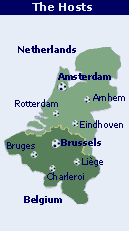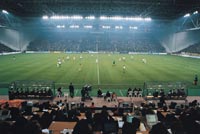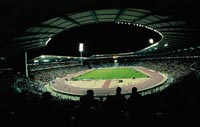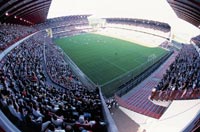|
|
|
![]()
Venues


Amsterdam Arena

Home club: AFC Ajax
Year built: 1996
Capacity: 50,000 seats
Queen Beatrix officially opened Amsterdam Arena on 14 August 1996. A multi-functional stadium that is primarily the home of AFC Ajax, it also homes American football club Amsterdam Admirals and is regularly used as a conference centre and to hold pop concerts. Designed by the architects Rob Schuurman and Sjoerd Soeters, it boasts two giant video screens, a number of restaurants and conference rooms and 50 catering outlets for fans. Its most remarkable feature is its retractable roof, consisting of two moving panels measuring 36 x 105 metres, which can be opened or closed in less than 20 minutes.
Gelredome, Arnhem

Home club: SBV Vitesse
Year built: 1998
Capacity: 30,000 seats
The space-age Gelredome is arguably the most modern stadium in Europe, boasting both an 800 tonne retractable roof as well as a retractable pitch. The pitch is in an 11,000 tonne container, moved by a computer-controlled hydraulic system that can remove or restore it in a matter of hours. Designed by the architectural firm Alynia Architecten Harlingen BV, the stadium features an environmentally-friendly system that provides heating in the winter and cooling in the summer. A multi-functional stadium, it is home to SBV Vitesse, who played their first match in the stadium in March 1998. Days later, the first major music act played at the stadium - the Spice Girls.
Jan Breydel Stadium, Bruges

Home club: Club Brugge KV & Cercle Brugge KSV
Year built: 1975
Capacity: 30,000 seats
Originally built as the Olympiastadion in 1975, Jan Breydel Stadium has undergone extensive renovation and expansion in recent years, as well as being re-named after one of Flanders’ foremost medieval rebel leaders. In that time, its capacity has been increased from 18,000 and it is now a 30,000 all-seater. It is home to city rivals and ground-sharers Club Brugge KV and Cercle Brugge KSV.
King Baudouin Stadium, Brussels

Home club: None
Year built: 1930
Capacity: 50,000 seats
The King Baudouin Stadium is the only EURO 2000™ Final Tournament stadium without a regular home team. Instead, it is home to the Belgian national team, which plays almost all of its matches there. Built on the former site of the Heysel Stadium, its renovation cost approximately BEF 1,500 million and it is now a 50,000 all-seater stadium. The whole stadium was renovated, although the original façade was preserved. It is the largest stadium in Belgium. Another multi-functional stadium, the first event to take place there after the renovation was completed was a concert by Céline Dion in June 1997.
Stade Communal, Charleroi

Home club: Royal Charleroi SC
Year built 1904
Capacity 30,000 seats
Home of R. Charleroi SC, Stade Communal is a state-of the-art venue which has undergone a major facelift in recent years with the EURO 2000™ Final Tournament in mind. Designed by the architectural team of Paul Petit & Associés SA – Charleroi, it has three new stands which were built between 1998 and 1999 and have been constructed in the shape of a pyramid. The stadium has been designed in such a way that, after the Championships, it can be reduced in capacity once more. The top tier seats will be removed and the roof lowered, leaving a two-tier stand and a ground capacity of 22,000.
Philips Stadium, Eindhoven

Home club: PSV Eindhoven
Year built: 1913
Capacity: 33,000 seats
The Philips Stadium has long led the way in the area of stadium innovation and was among the first to embrace the multi-function concept that is now so popular. Although built in 1913, it has been continually renovated, redesigned and improved since 1988 - work which continues to this day. As a result the stadium is in use every day of the year for functions and events of one form or another. The ground now features a large number of luxury halls and conference rooms and fans and spectators are catered during live performances and matches by four huge video screens.
Sclessin Stadium, Liège

Home club: R. Standard de Liège
Year built: 1984
Capacity: 30,000 seats
Sclessin Stadium has been specially renovated for the EURO 2000™ Final Tournament. It was formally opened in its current incarnation in 1999, but the stadium has been worked on steadily since 1984 when the first phase was completed. A second new stand was built in 1993 and in 1998 another was added on the River Meuse side, constructed in a way that allows large vehicles to enter the stadium directly. Built by the architectural companies of Adviesbureau R. Greisch S.A. and architectenbureau Audex, it imitates an English stadium, with the stands close to the pitch to enhance the atmosphere. The first match played after the official re-opening was a friendly match between Belgium and Egypt 0n 30 March 1999.
Feijenoord Stadium, Rotterdam

Home club: Feyenoord
Year built: 1937
Capacity: 50,000 seats
Nicknamed De Kuip (‘The Tub’), Feijenoord Stadium was built in 1937, but extensive construction and renovation work has ensured it has kept its place among the vanguard of football grounds in Europe. The latest renovation works, commenced in 1994, include ditches around the pitch to replace fences, new roofing that ensures 80% of all spectators are in covered seating, and staircases and exits which enable a full stadium to be emptied in just six to eight minutes. It has a removable roof, heated pitch and 50,000 seats - every one of which has an excellent and uninterrupted view of the action. As testament to its superb layout, facilities and match-day atmosphere, the stadium has hosted a record eight UEFA competition finals.
